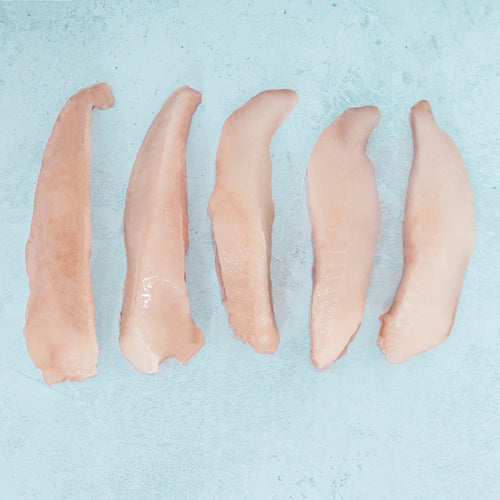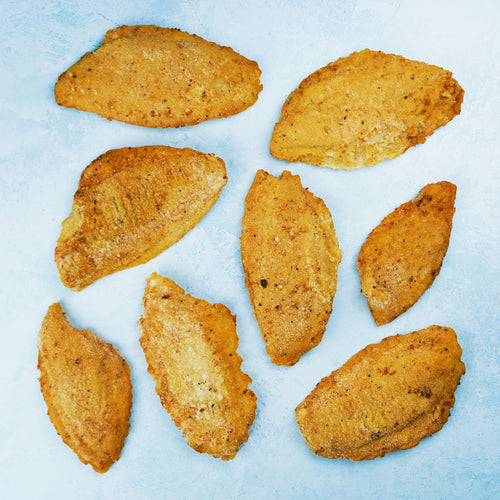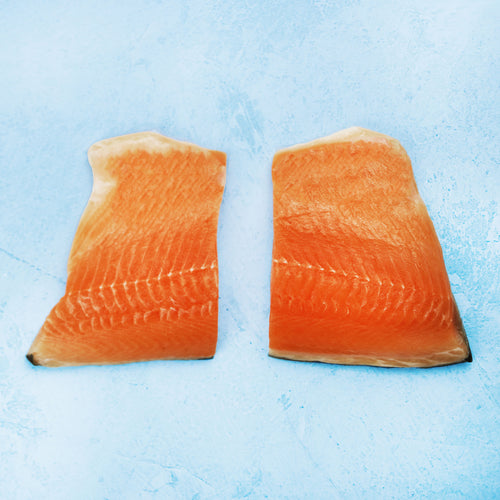Stone Bass is on the rise
About a year ago we started to see stone bass emerging on seafood merchant’s price lists and restaurant menus. We were mildly curious in this new fish but didn’t immediately enquire further.
A month or two later we were talking about sea bass and the merits of the farmed fish coming from Greece and Turkey. The one thing we agreed that let this popular fish down was its size. We were not able to find fish large enough to yield our luxury signature cut – ‘fillet steak’. A sea bass of 3KG plus would give you this cut, but they are increasingly harder to acquire and will cost a small sack of gold.
 At this point, we started reconsidering stone bass after hearing you can buy them at a size of 7KG plus! In the world of farmed fish, this is a big achievement! Putting our main motivation of a gloriously large stone bass fillet steak aside, we saw it as a good substitute to the pressured wild Atlantic sea bass.
At this point, we started reconsidering stone bass after hearing you can buy them at a size of 7KG plus! In the world of farmed fish, this is a big achievement! Putting our main motivation of a gloriously large stone bass fillet steak aside, we saw it as a good substitute to the pressured wild Atlantic sea bass.
So what is stone bass?
Dare we say it? Stone bass is, in fact, a ‘marketing’ name for a fish species called meagre from the Sciaenide family. You can understand why they didn’t think it’s normal name was that sexy can’t you? If you would like to learn more about meagre it’s latin name is Argyrosomus regius. Depending on where you are in the world you may see it described as salmon bass, shade-fish or even corvina.
 Estimate: 4KG fish
Estimate: 4KG fish
In the wild, this fish has been reported to grow to 2 metres in length and up to 55 KG. Most of the world’s wild stone bass are caught off the coast of Egypt and Morocco.
The table below shows farmed stone bass is quite a new global offering and it only became commercially available from about 2010 onwards.

We get really excited when we see new species like the stone bass being successfully farmed to an unprecedented size. We have seen similar trends recently with Gigha and their large 8KG Halibut. This trend gives us an enthusiasm for the future of the global farmed fish offering.
 Alistair very happy with the two large farmed halibut from Gigha
Alistair very happy with the two large farmed halibut from Gigha
Stone bass recipes
If you Google ‘stone bass recipes’ you will start to find some new and exciting flavour combinations from food bloggers, restaurants, cookery schools and chefs. Have a look at a few of these:
Stone bass with new potatoes, tomatoe concasse and chives
Michel Roux Jr – Asian style stone-bass
Sumac marinated stone bass with beetroot risotto recipe
Our stone bass recipe – Stone bass in a nut crust
 In the nut crust ready for the pan
In the nut crust ready for the pan
Ingredients:
2 x boneless & skinless stone bass fillet steaks
100G Shelled pistachio nuts
1 tbsp of sesame seeds
2 teaspoons of Sichuan pepper
Plain white flour
2 eggs
Salt & pepper
Cous cous
200G cous cous
250ml veg stock or water
50g Sun dried tomatoes
1 Bunch of Greek basil
Tblsp tomato pesto
Red onion
Salt & Pepper
Method:
1. Peel the pistachios and put them in a bowl with the Sichuan pepper and sesame seeds. Crush or cut them until the nuts are in small pieces (see photos). Place the crushed mix in the oven on bake at 180c for 10 minutes or until they have browned
2. Add 250ml of vegetable stock or water to the cous cous and set aside for 5-7 minutes to absorb the water. In the meantime cut the onion, sun dried tomatoes and Greek basil finely and mix into the cous cous once the cous cous has absorbed all of the water. Finally, add a tablespoon of tomato pesto. Season the cous cous with salt and pepper.
Using three bowls: pour flour in the first bowl, beat two eggs in the second bowl and pour the toasted nut mix from the oven in the last bowl. Season the fish, roll it in the flour, dunk it in the egg and coat it in the nut mix.
3. Add a tablespoon of oil to the pan on a medium heat and place the fish in the pan. Be careful that the nuts do not burn. Allow 3-4 minutes per side (depending on fillet thickness).
4. Serve the fish along-side a bowl of warm cous cous on freshly sliced beef tomatoes and steamed samphire.
New in
Find exactly what you want. We sell 200 kinds of fish - way more than anyone else.
SHOP NEW IN






